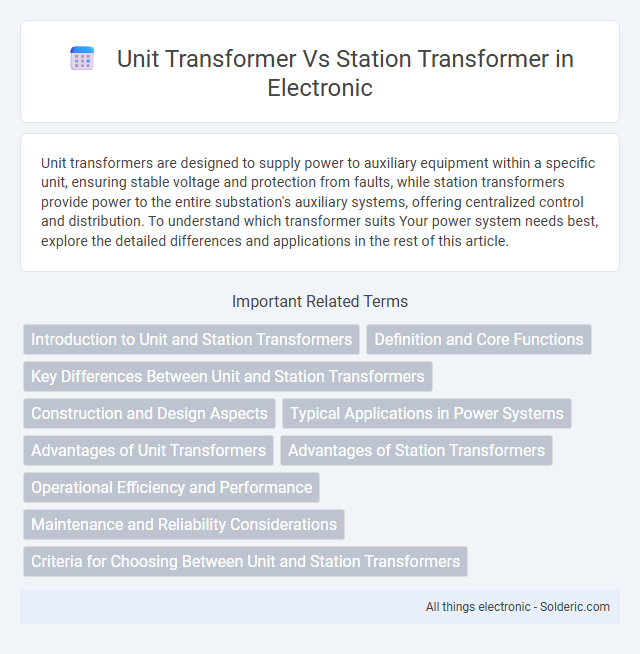Unit transformers are designed to supply power to auxiliary equipment within a specific unit, ensuring stable voltage and protection from faults, while station transformers provide power to the entire substation's auxiliary systems, offering centralized control and distribution. To understand which transformer suits Your power system needs best, explore the detailed differences and applications in the rest of this article.
Comparison Table
| Aspect | Unit Transformer | Station Transformer |
|---|---|---|
| Function | Steps down voltage for auxiliary equipment within a unit | Steps down voltage for entire substation or plant auxiliary loads |
| Location | Located near generating units or specific equipment | Located at centralized substation facilities |
| Capacity | Typically lower capacity (kVA to few MVA) | Higher capacity suited for broader load distribution |
| Voltage Levels | Commonly medium to low voltage for equipment use | Medium voltage input, stepped down to low voltage for general use |
| Usage | Feeds auxiliary systems like control panels, motors adjacent to units | Feeds lighting, power panels, and auxiliary loads across station |
| Design | Compact, tailored for specific unit needs | Larger, robust design for extensive station use |
| Reliability | Critical for uninterrupted unit operation | Ensures power supply to station-wide auxiliary systems |
Introduction to Unit and Station Transformers
Unit transformers are specialized transformers installed within electrical units or equipment to provide localized voltage transformation and regulation, enhancing operational efficiency and safety. Station transformers, on the other hand, are larger transformers located in substations, designed to step down high transmission voltages to lower levels for distribution to various connected loads or systems. Both types play critical roles in electrical power systems, ensuring reliable voltage management and power quality across different stages of energy distribution.
Definition and Core Functions
A unit transformer is designed to provide electrical power directly to a specific piece of equipment or localized load within an industrial plant, ensuring voltage regulation and isolation for operational safety. A station transformer primarily serves as an auxiliary power source for the substation itself, supplying electricity to control panels, lighting, and auxiliary devices critical for station functionality. Both transformers play essential roles in electrical distribution, with unit transformers focusing on load-specific power delivery and station transformers supporting substation infrastructure reliability.
Key Differences Between Unit and Station Transformers
Unit transformers are designed for load-specific applications within power plants, providing voltage transformation close to the generator and ensuring efficient power delivery to specific units. Station transformers serve a broader function by distributing power throughout the entire substation, supplying auxiliary loads, and maintaining station equipment operation. The key differences lie in their placement, load capacity, and role in the electrical grid, with unit transformers focusing on individual units and station transformers managing overall substation power needs.
Construction and Design Aspects
Unit transformers are typically compact and integrated directly with the power generating or electrical equipment, featuring oil-filled or dry-type insulation designed for indoor installation and close coupling to generators or motors. Station transformers, on the other hand, exhibit a larger, more robust construction with heavy-duty cooling systems, often installed outdoors or in substation environments to handle auxiliary loads and provide voltage regulation across the entire power station. Your choice between these transformer types depends on space constraints, cooling requirements, and the specific operational role within the electrical network.
Typical Applications in Power Systems
Unit transformers are primarily used in power plants to step down voltage levels for auxiliary equipment, ensuring safe and reliable operation within the generation unit. Station transformers serve to supply power to the substation's auxiliary loads, such as control equipment and lighting, maintaining the substation's operational integrity. Both types are essential in power systems for isolating and protecting auxiliary circuits, but unit transformers are closely tied to generation units while station transformers support overall substation infrastructure.
Advantages of Unit Transformers
Unit transformers offer enhanced reliability by serving individual units directly, minimizing the impact of faults on the entire substation. Their modular design simplifies maintenance and reduces downtime, ensuring consistent power supply. You benefit from improved voltage regulation and better fault isolation compared to station transformers, optimizing overall system performance.
Advantages of Station Transformers
Station transformers provide increased reliability by supplying continuous power to auxiliary systems during main transformer outages. They enhance operational flexibility through independent control and maintenance, reducing downtime in power stations. These transformers also offer improved voltage regulation and better protection for critical equipment compared to unit transformers.
Operational Efficiency and Performance
Unit transformers enhance operational efficiency by supplying power directly to individual units, minimizing energy loss and ensuring consistent voltage regulation. Station transformers maintain overall grid stability by distributing power across multiple units, optimizing load management and improving system reliability. Your choice depends on whether localized precision or broader network performance is prioritized in your power system.
Maintenance and Reliability Considerations
Unit transformers require more frequent maintenance due to their critical role in powering auxiliary systems within the unit, with a focus on promptly addressing insulation and cooling system issues to ensure uninterrupted operation. Station transformers generally benefit from lower maintenance demands and enhanced reliability, given their stable load conditions and robust design tailored for substation power supply. Your maintenance strategy should emphasize regular testing and condition monitoring for unit transformers to prevent unexpected failures and extend service life.
Criteria for Choosing Between Unit and Station Transformers
Criteria for choosing between unit transformers and station transformers revolve around capacity, application, and installation constraints. Unit transformers are preferred in industrial settings for direct integration with machinery, offering localized voltage regulation typically between 50 kVA to 5000 kVA. Station transformers, on the other hand, serve broader distribution needs within substations or power plants, supporting higher capacities often exceeding 10 MVA, making your choice dependent on whether the focus is on equipment-specific power supply or large-scale grid voltage management.
unit transformer vs station transformer Infographic

 solderic.com
solderic.com